
Introduction to Flutterflow: Create Apps Fast Without Coding
It is widely acknowledged that Flutter, a leading cross-platform framework, was popular (46% used by software developers in 2023) due to its ability to speed up and improve the efficiency of the development process. The power of Flutter is now available in FlutterFlow, a simple drag-and-drop interface that doesn’t require any coding expertise.
It is just like a small packet of big bangs!
Flutter and FlutterFlow differ primarily in how they approach development. While Flutter is a framework for cross-platform development, FlutterFlow emerged as a potent tool for creating web and mobile applications in 2023. It provides a visual interface along with several features that make the process of developing apps quicker and easier.
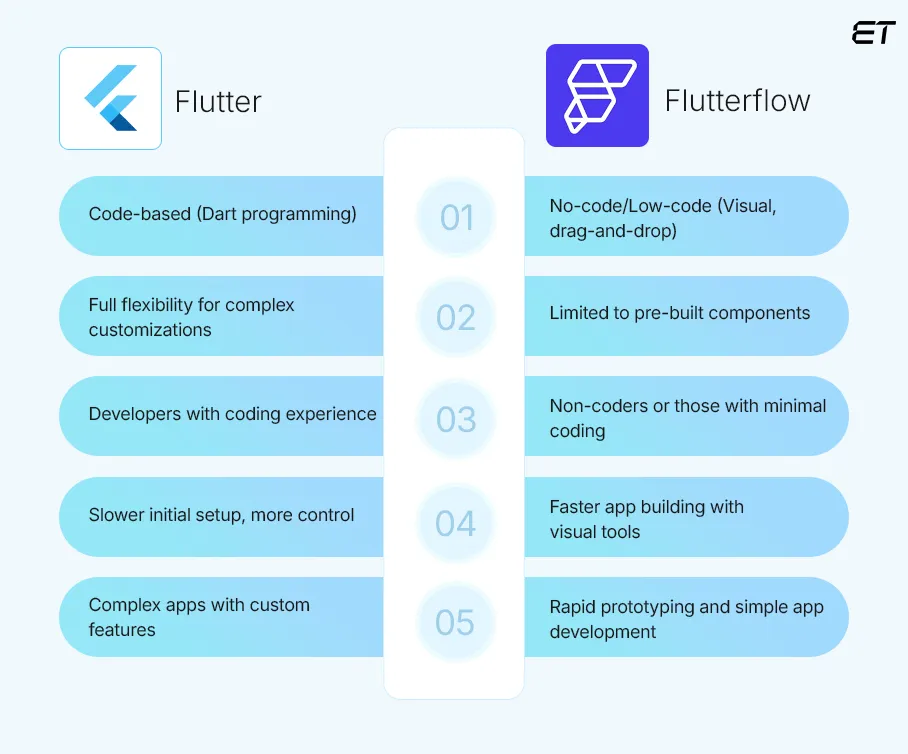
Nowadays, everyone wants quality, but they also want it within their budget! High-quality app development usually takes a lot of time and money, with developers creating a lot of code to produce a product ready for the market.
Using no code or little code in app development is one of the best technologies for making developers’ jobs easier and reducing overall costs.
According to the creators of FlutterFlow (Abel Mengistu and Alex Greaves, two former Google engineers), this tool streamlines the app development process, enabling developers, business owners, and organizations to create apps “10X faster.”
For non-developers, FlutterFlow is an excellent tool for creating mobile applications. It is the preferred option for many developers and companies due to its ability to use AI and enable teams to develop and execute useful and aesthetically pleasing products quickly.
At eLuminous Technologies, we have used this tool to develop various flawless apps for our clients. Although it doesn’t require any coding knowledge and is simple to use, it has certain drawbacks, like a lack of personalization choices and dependence on outside updates.
This blog post will explain FlutterFlow, its main attributes, advantages, and possible disadvantages, as well as how it fits into the larger app development ecosystem.
When you’re done, you’ll know how FlutterFlow can effectively handle your app development requirements and keep your apps updated.
So, without further delay, let’s dive in!
What is Flutterflow?
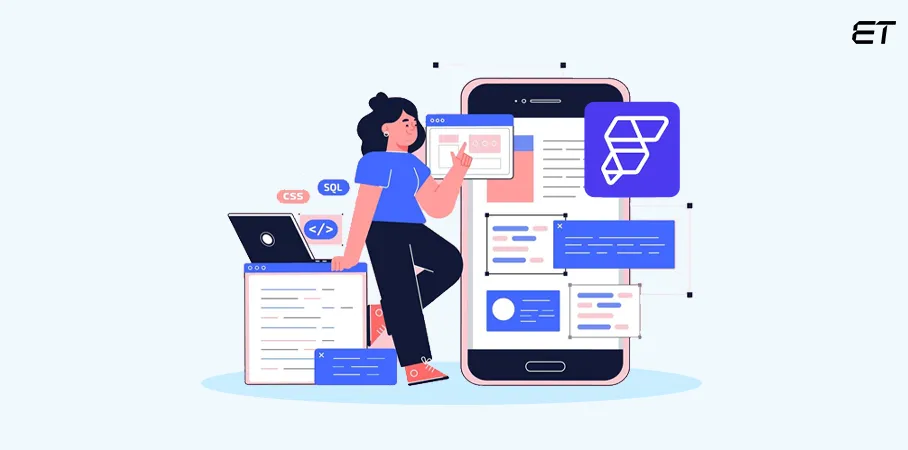
FlutterFlow is an innovative low-code development platform that uses the Flutter framework to facilitate developers’ smooth creation of mobile applications. The tool removes the need for manual coding by providing practical interfaces that facilitate the design and development of excellent apps.
Its user-friendly drag-and-drop interface makes it simple for users to build workflows, design interfaces, and make animations. The platform is a compelling choice for non-developers or those wishing to quickly prototype their app ideas because it automatically creates Flutter code depending on user actions.
A complete app can be designed and developed on a platform with FlutterFlow. With features like push notifications, animations, API compatibility, and Firebase connection, this tool reduces the time and expense required to create fully working apps.
It utilizes Flutter’s programming language, Dart code. The Dart language has many advanced characteristics. The tool, for example, enables the writing of a single line of code and compiles it into the architecture of many platforms.
Flutter Flow enables users to quickly create applications, build visually appealing user interfaces, get clean code, and publish to app stores or the web with just one click.
FlutterFlow Uncovered: Clearing Common Misconceptions
As this is a new platform, there is some confusion about it, so let’s clear it up!
Is FlutterFlow better than Flutter?
Your project’s requirements will determine which FlutterFlow and Flutter platforms are best for you. For seasoned developers, Flutter provides greater control, flexibility, and customization, but FlutterFlow is best suited for simpler applications with a quicker turnaround time. Each offers advantages based on the project’s demands.
Is FlutterFlow Free?
FlutterFlow offers a free plan with basic features, allowing users to create apps without cost. However, advanced features like custom code, API integration, and export options are part of paid plans, starting with premium access subscription tiers. Have a look at all the paid plans of this tool.
Is FlutterFlow no code?
Yes, FlutterFlow is primarily a no-code platform designed to help users build mobile and web apps visually without writing code. It offers drag-and-drop functionality and pre-built components. However, more complex customizations allow users to add custom code, bridging the gap between no-code and code development.
Is FlutterFlow a product of Google?
No, FlutterFlow is not a Google product. It was developed by two former Google engineers, Abel Mengistu, and Alex Greaves, but it operates independently as a separate company. However, FlutterFlow is built on top of Flutter, Google’s open-source UI framework, which allows developers to create natively compiled applications for mobile, web, and desktop from a single codebase.
Exploring the Key Features of FlutterFlow for Efficient App Building
FlutterFlow brings an intuitive, low-code/no-code approach to creating fully functional cross-platform apps for iOS, Android, and the web. Here’s a detailed breakdown of its top features:
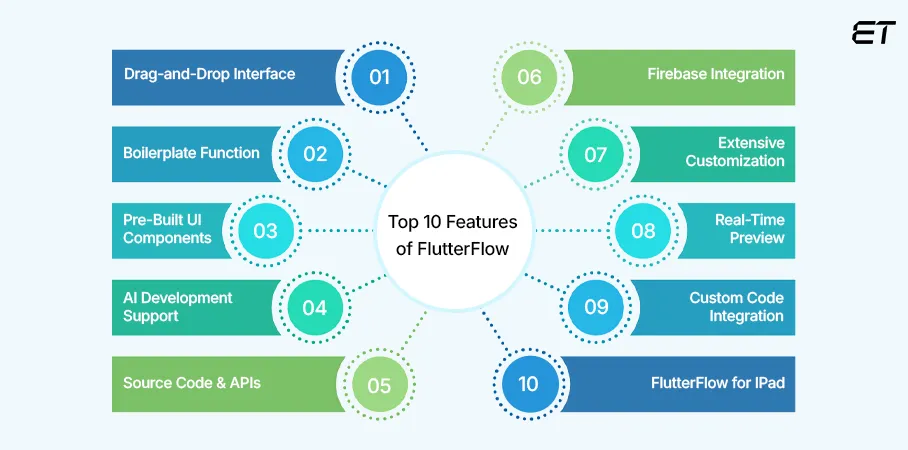
1. Drag-and-Drop Interface
The drag-and-drop app builder capabilities of FlutterFlow are among its most noteworthy features. By choosing and positioning widgets on the canvas, this feature enables users to create intricate user interfaces easily. With the platform’s extensive selection of themes, pre-built widgets, and integrations, you can make a polished and useful app or web application without knowing any code.
Users can design intricate layouts by simply dragging pre-built elements onto the canvas, such as buttons, text fields, containers, and photos. This visual method allows for quick iterations and greatly lowers the learning curve. This time savings in layout design are beneficial even for the expert development team.
2. Boilerplate Function
Fragments of prewritten code are known as boilerplate codes. You can always access boilerplate functions using the FlutterFlow visual editor. Ideally, boilerplate codes consist of the parts of the code necessary for the product to work properly. These parts can be used again for various tasks in the app development process.
FlutterFlow boilerplate functions reduce development time by offering pre-written, reusable code templates. By standardizing typical tasks, they lessen the need for repetitive code writing. In this way, developers may concentrate on features unique to their apps rather than fundamental operations by ensuring uniformity, making the code easier to read, and streamlining maintenance.
3. Pre-Built UI Components
FlutterFlow offers a wide range of pre-built UI components to streamline app development. You can use these resources as a foundation for your projects and then modify and expand upon them to meet your unique requirements.
Here’s a list of key components:
1. Text (Label, Header, Paragraph)
2. Buttons (Standard, Icon, Floating Action)
3. Forms (TextField, Dropdown, Checkbox, Radio Button)
4. Containers (Box, Card, ListTile)
5. Media (Image, Video, Audio)
6. Navigation (AppBar, Bottom Navigation Bar, Drawer)
7. Charts (Pie, Line, Bar)
8. Grid/List View
9. Icons
10. Slider, Progress Bar
11. Tabs
12. Calendar
With FlutterFlow’s pre-made components, you can create essential features like image galleries, payment gateways, and login forms without starting from scratch, whether you’re creating a basic e-commerce app or a more intricate social media platform. Additionally, this makes it simple to keep the app’s look consistent throughout.
4. AI Development Support
Another noteworthy feature is support for AI development. The FlutterFlow platform makes it simple for developers to incorporate AI to expedite app development and modify various features to suit the objectives of the final product. AI prompts are the greatest way to speed up quick creation and customization procedures.
With AI-assisted app creation, dedicated developers can create applications even more quickly. AI prompts give developers quick customization choices, speeding up the process of developing apps.
The tool incorporates AI into its proprietary code editor for more efficient code production and suggestions. This feature makes it easier to use text inputs to create visually appealing and distinctive color schemes.
Find the cost to build an AI app.
5. Source Code & APIs
API integration is essential for dynamic apps that depend on outside data, like news apps, weather apps, or apps that need to communicate with outside services.
Find the top 10 API integration platforms in 2024.
Regarding this tool, REST APIs are simple to incorporate into your application using FlutterFlow, which enables you to retrieve and present data from outside sources. The platform supports more complex use cases for users familiar with APIs but offers a straightforward method of connecting to APIs without writing much code.
This capability allows users with greater expertise to alter the generated code, add new features, and increase the functionality of their apps. The “External API” widget allows you to add third-party services, such as social media sites or payment gateways and offers API support.
6. Firebase Integration
Firebase, Google’s well-known Backend-as-a-Service (BaaS) technology, can be seamlessly integrated with FlutterFlow. Without manually deploying servers, dedicated Flutter developers can use Firebase to integrate backend services like real-time databases, authentication, cloud storage, and cloud functions into their apps.
Every time updates are made, push alerts are sent to the Firebase cloud messaging, improving real-time feedback in the app. As a result, any modifications made to the program take effect instantly without requiring a rebuild or reload. Developers can easily create sophisticated and scalable apps with FlutterFlow’s Firebase without spending as much time programming the app from scratch.
Because of this feature, managing back-end services is less complicated, and FlutterFlow is appropriate for creating data-driven applications like social networks, messaging apps, and e-commerce solutions.
7. Extensive Customization
Another noteworthy aspect is the wide range of customization possibilities this tool offers. Although FlutterFlow’s focus is on no-code development, developers can add custom code and customize their applications to meet specific requirements, guaranteeing flexibility and distinctive functionality. You can use this feature to expand the platform’s functionality and modify the app to fit certain needs, ensuring the finished output reflects your vision.
Additionally, FlutterFlow allows for the integration of custom code and APIs, enhancing functionality and flexibility. This enables developers to maintain design consistency while rapidly prototyping and deploying apps, ultimately streamlining the development process and improving creativity. As a result, FlutterFlow significantly reduces development time while providing the tools for unique, high-quality app designs.
8. Real-Time Preview
Thanks to FlutterFlow’s real-time collaboration feature, team members can collaborate easily from anywhere in the world. Because of this functionality, users can view updates as soon as they build their app. This immediate feedback helps users improve the functionality and design of their apps without constantly rebuilding or refreshing them.
Developers may see the effects of code changes instantaneously thanks to the platform’s support for hot reload, a capability that was carried over from Flutter. The development process is significantly accelerated, making testing and iteration considerably quicker and more effective.
9. Custom Code Integration
FlutterFlow acknowledges the value of flexibility even as it works to reduce the amount of coding required. It gives experienced Flutter developers the ability to develop custom Dart code to increase the functionality of their projects.
FlutterFlow allows for the integration of custom code and APIs, enhancing functionality and flexibility. This enables developers to maintain design consistency while rapidly prototyping and deploying apps, ultimately streamlining the development process and enhancing creativity. As a result, FlutterFlow significantly reduces development time while providing the tools for unique, high-quality app designs.
This flexibility fosters creativity because teams can build complex algorithms or unique features unavailable through default options. Additionally, because developers have complete control over the logic, bespoke code makes debugging and speed optimization easier. Ultimately, this functionality allows developers with particular requirements greater customization options by bridging the gap etween traditional coding and no-code.
Top 10 Flutter development tools in 2024.
10. FlutterFlow for IPad
An additional exciting feature is that FlutterFlow can be used on iPads. This makes web apps more mobile-friendly and improves their functionality. Developers can design and prototype applications while on the go with FlutterFlow for iPad. This tool enhances productivity and creativity by enabling teams to develop and test applications efficiently from the comfort of an iPad through features like real-time collaboration and custom code integration.
Pros and Cons of FlutterFlow: Is It the Right Tool for You?
Even though FlutterFlow has been praised for being user-friendly and versatile, it’s crucial to assess both its advantages and disadvantages in order to determine whether it meets particular development requirements. Below is an in-depth look at the pros and cons of this tool.
FlutterFlow Pros: Why It’s Ideal for Rapid App Development?
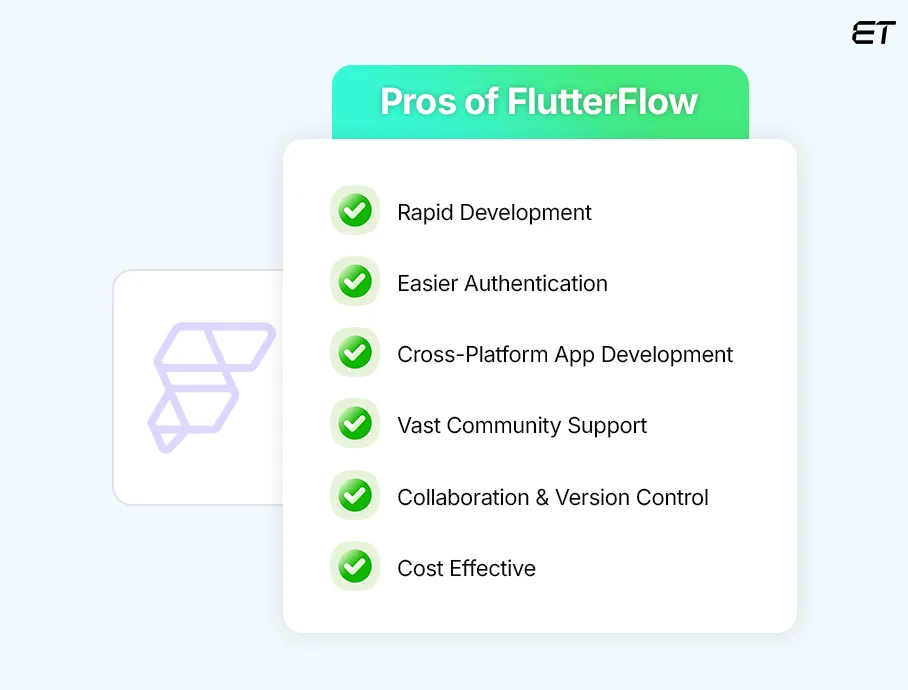
-
Rapid Development
FlutterFlow is a tool for rapidly developing simple web pages and mobile applications. One of its biggest benefits is its drag-and-drop interface, which enables even non-developers to design and construct apps with little to no coding knowledge by dragging and dropping user interface elements, setting up workflows, and connecting databases. Writing thousands of lines of code is necessary for traditional development, but FlutterFlow significantly cuts down on development time by automating a large portion of the process.
-
Easier Authentication
Flutter developers can rapidly set up user authentication without requiring a lot of coding because of FlutterFlow’s seamless interaction with Firebase, which streamlines authentication. With its support for many authentication methods, such as social logins, Google, and email, users can effortlessly handle sign-ups, logins, and password resets. This simplified procedure makes backend setup less complicated, allowing mobile apps to integrate secure authentication features more quickly.
Read about how to make a project using FlutterFlow with Firestore and Firebase.
-
Cross-Platform App Development
Since Flutter is the foundation of FlutterFlow, cross-platform programming is naturally supported. You can create apps that function flawlessly on iOS and Android smartphones with a single codebase. Native app development, on the other hand, allows you to make an application tailored to a specific operating system. This cross-platform app development maximizes performance and consistency, expediting the development process.
Why is Flutter best for cross-platform app development?
-
Vast Community Support
FlutterFlow benefits from a vast and active community of developers, designers, and users who share resources, tutorials, and troubleshooting advice. This collaborative environment provides valuable support through forums, social media groups, and documentation, making it easier to find solutions to challenges. In addition, newbie designers and other app developers can also learn how to utilize Flutterflow tutorials from the start with the help of several videos and blogs.
-
Collaboration & Version Control
FlutterFlow’s support for collaborative development allows multiple team members to work on a project efficiently. They can also monitor changes, control permissions, and revert to earlier iterations as needed.
Version control tools in FlutterFlow make it easier for developers to manage various project stages effectively. This is particularly helpful for collaborative teams because it lets members update without worrying about losing work. Additionally, version control allows developers to safely test new features while maintaining the stability of existing versions.
-
Cost Effective
FlutterFlow is cost-effective because it significantly reduces the need for large development teams and reduces development time. Its low-code/no-code methodology removes the need to hire dedicated developers and enables even non-technical users to create fully functional mobile apps.
Moreover, the platform’s cross-platform capability ensures that a single app can be deployed on both Android and iOS, further reducing costs. Its low-cost subscription model also reduces the need for pricey third-party services and infrastructure when combined with integrated connectors like Firebase.
How much does it cost to develop mobile apps in 2024?
Cons of FlutterFlow: Where It Falls Short in App Development?
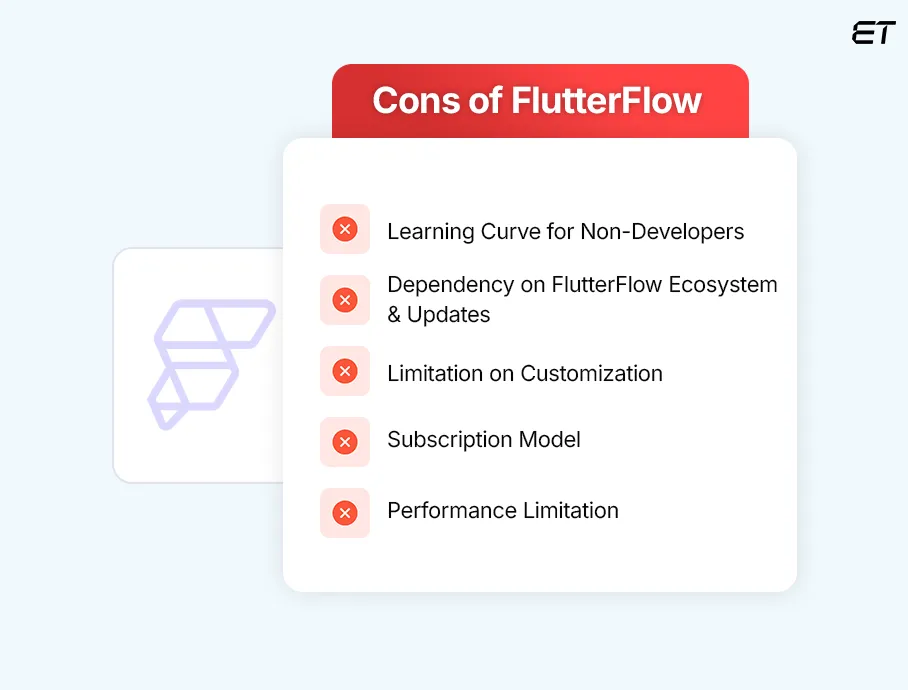
-
Learning Curve for Non-Developers
Despite its user-friendly design, FlutterFlow still has a learning curve for non-developers, particularly when it comes to ideas like data structures, Firebase integration, and API management.
Some people who were hoping for a completely plug-and-play experience could be put off by this. Furthermore, even while creating a basic app is easy, sophisticated features may still call for some knowledge of coding principles, which may reduce the number of actual “no-code” users.
-
Dependency on FlutterFlow Ecosystem & Updates
FlutterFlow is a platform that relies more on frequent updates and upkeep. Although frequent updates are beneficial in many respects, they may hinder the progression of projects. For example, the project as a whole may be impacted by incompatibility with certain new technology and resources. The development process may be affected by any modifications to platform capabilities, pricing, or feature discontinuations.
-
Limitation on Customization
The platform is mostly made for drag-and-drop functionality, but you can also add custom code. Despite providing useful pre-made components that expedite development, FlutterFlow has limitations with regard to customisation, particularly for complex applications. This limits developers who wish to create complex or highly specialized features that surpass the platform’s built-in elements.
-
Subscription Model
With a free plan that includes basic functions and paid plans with advanced functionalities, FlutterFlow’s subscription model enables tiered pricing alternatives to accommodate varying needs. Features like Firebase support, API connections, team collaboration, and custom code integration are unlocked by paid plans, making it flexible for both lone developers and larger teams. On the other hand this subscription model can be burdensome for individual developers or small companies with limited funding.
-
Performance Limitation
Although FlutterFlow is based on the well-known high-performance Flutter framework, complex programs may have performance issues due to the platform’s low-code/no-code nature. Performance may deteriorate with the use of numerous components or intricate logic, resulting in slower load times or less responsiveness. In addition, apps that handle a lot of data, have a lot of components, or have a lot of animations may not be as optimized as those that were created using Flutter directly.
After weighing the benefits and drawbacks listed above, we can say that FlutterFlow presents a strong option for novice and experienced developers seeking a quicker and simpler approach to creating cross-platform applications. The restrictions on customization and performance, however, could be a disadvantage for intricate, highly customized apps or those that need a lot of optimization.
Top 5 Apps Build Using FlutterFlow Tool
| App | Category | Why FlutterFlow |
 |
B2B Pharmaceutical Marketplace | This B2B platform connects pharmaceutical manufacturers, wholesalers, and distributors. It needed a scalable and flexible solution to handle dynamic data and various user types (suppliers, buyers, manufacturers). FlutterFlow’s easy integration with REST APIs and Firebase Firestore allowed Pharmerz to display real-time product listings, manage user authentication, and effortlessly handle large amounts of transactional data. |
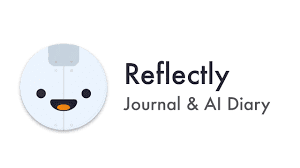 |
Mental Health & Journaling | Reflectly, a personal journal app powered by AI to improve mental well-being was built using this tool to create an intuitive, visually appealing user interface. Speed of development and cross-platform support were key reasons for choosing FlutterFlow, allowing Reflectly to reach both Android and iOS users without duplicating effort. |
| |
Healthcare Solutions for Underserved Communities | This app provides health services in rural areas where traditional access to healthcare is limited. The team needed a platform that allowed for offline functionality and easy backend integration. FlutterFlow’s Firebase integration allowed them to manage healthcare data and enable offline capabilities when users had limited internet access. |
 |
Personal Growth & Productivity | Karmalogy, a personal development app for habit and mindfulness tracking, leveraged FlutterFlow’s time-saving drag-and-drop interface to rapidly design and iterate their UI. Firebase Authentication and Firestore enabled user profiles and data tracking without a backend team, while cross-platform support allowed simultaneous targeting of both iOS and Android users. |
 |
Ride-sharing Service | Uride, a ride-hailing app for smaller cities, chose FlutterFlow for its ability to manage real-time data, including ride tracking, driver location, and fare calculations, through Firebase’s real-time database. FlutterFlow’s API integration supported third-party mapping and payment services, while exportable Flutter code enabled customization of complex features like route optimization and geofencing. |
Conclusion
The emergence of cutting-edge tools and technologies like Flutter and FlutterFlow has streamlined and digitalized the process of developing mobile apps. Both of them have unique advantages and meet particular requirements.
Your objectives and requirements should be carefully considered when selecting a tool for your upcoming app development project. A poor choice can lead to wasted resources, limitations in features, and longer development times, affecting overall success.
If you’re searching for an easy-to-use solution that will enable you to rapidly and effectively create a cross-platform application, FlutterFlow might be a fantastic choice.
However, you must read this blog and consider the advantages and disadvantages of this tool according to your particular needs before selecting it. Consider the benefits while keeping in mind its drawbacks to guarantee a fruitful app development process.
If you’re having trouble comprehending anything, talk to our Flutter experts now!
At eLuminous Technologies, a leading Flutter app development agency we offer reliable, all-inclusive, and superior end-to-end Flutter development services. Contact us right now to discuss your app development needs and learn more about what Flutter and FlutterFlow can provide.
Frequently Asked Questions
Is studying Flutterflow worthwhile?
Yes, studying FlutterFlow is worthwhile, especially for those looking to build apps quickly without deep coding knowledge. It streamlines app development, making it ideal for creating MVPs, prototyping, and cross-platform apps with reduced costs and time investment.
Where is FlutterFlow used?
FlutterFlow’s best use cases include building MVPs for startups, creating cross-platform apps for e-commerce, social media, and booking systems, and developing internal business tools. It’s ideal for rapid prototyping, mobile apps requiring Firebase integration, and projects with limited budgets or tight timelines needing efficient deployment.
Is Flutterflow good for ecommerce apps?
Yes, e-commerce apps are a good fit for FlutterFlow. Its capabilities, which include payment gateway compatibility, smooth Firebase connection, and easily customizable user interface elements, enable the efficient development and quick implementation of cross-platform e-commerce solutions.
Which is better at creating highly functioning apps, Flutter or FlutterFlow?
Flutter is better for creating highly functional and complex apps, offering greater customization, performance optimization, and flexibility through code. FlutterFlow, while easier to use with its no-code/low-code interface, is ideal for simpler apps or MVPs, but may lack the depth needed for advanced functionalities.
Which platforms are supported by FlutterFlow?
FlutterFlow supports development for both Android and iOS platforms, allowing users to create cross-platform mobile applications from a single codebase. Additionally, it has expanded to support web applications, making it versatile for multi-platform app deployment.



